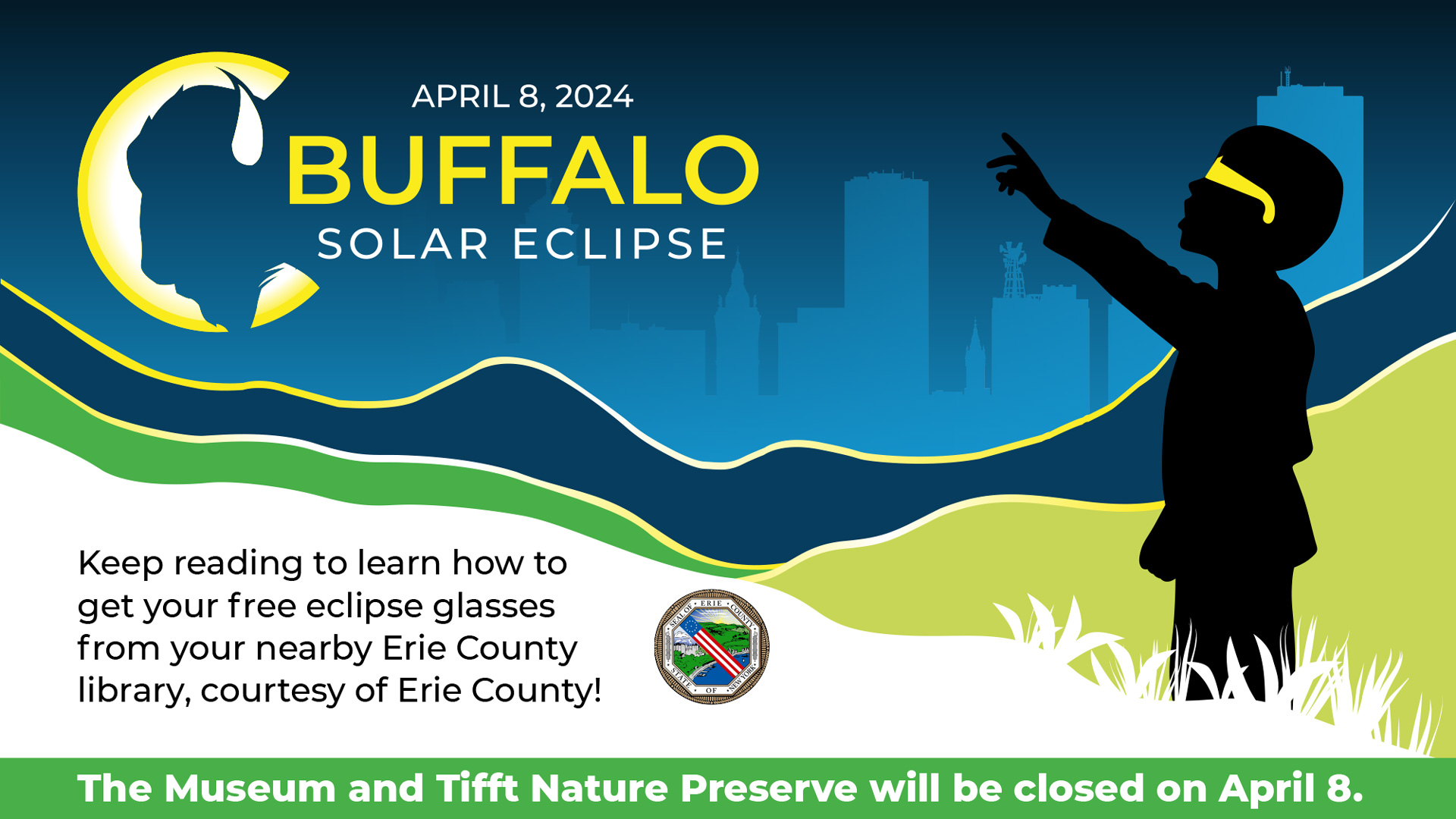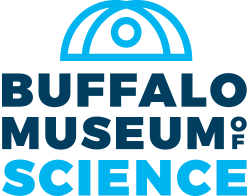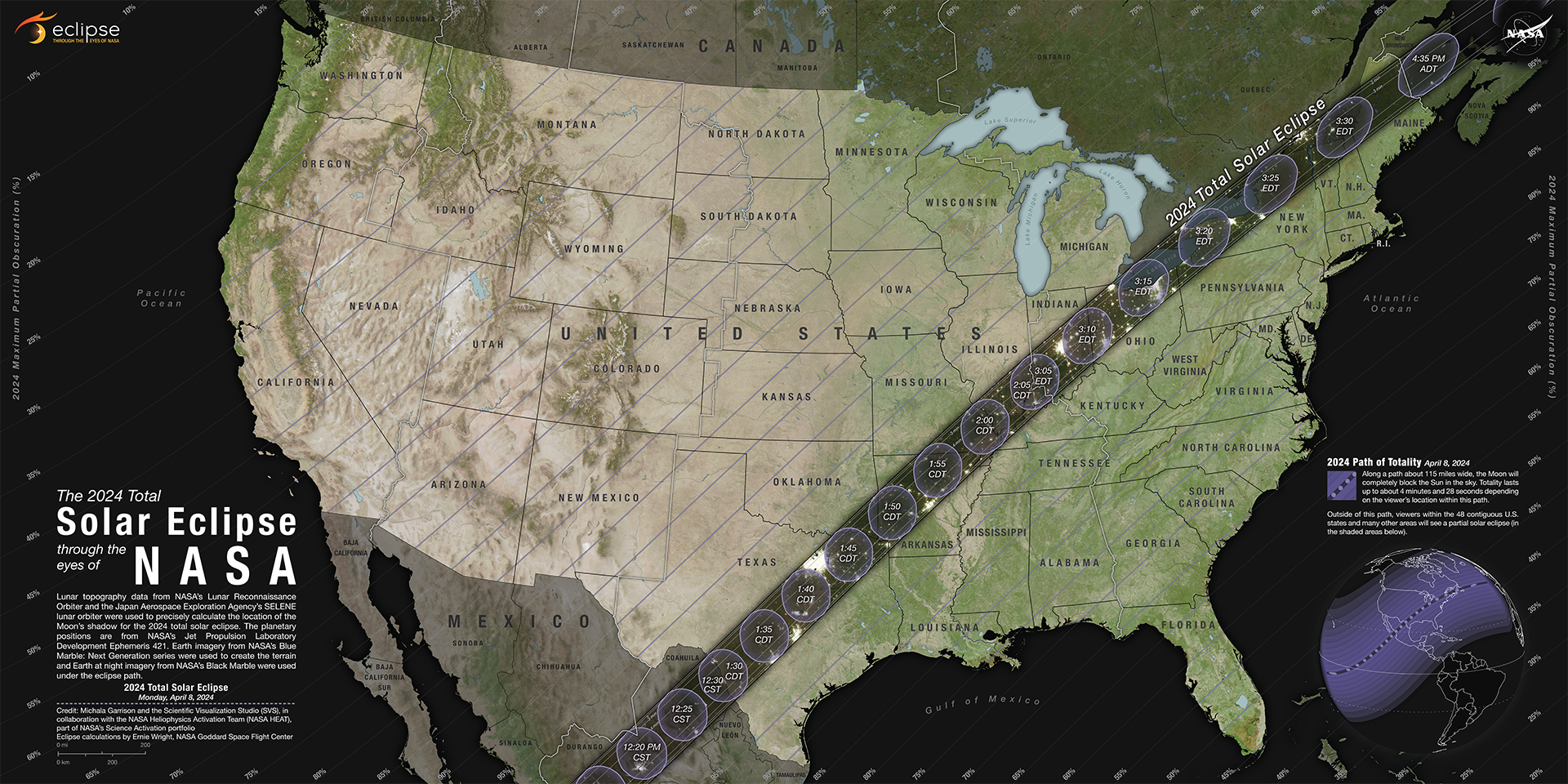- Home
- 2024 Eclipse Safety

The Eclipse is almost here!
The Museum will be closed on April 8, 2024, to allow our team members to experience this once-in-a-generation moment in science with family and friends.
Erie County is preparing for as many as one million tourists to the Buffalo region for the 2024 eclipse. We encourage Buffalo-area residents to stay at home or at a location where they can comfortably stay for a while before, during, and after the eclipse, so that they are in a safe location to enjoy this historical astronomical event for our area.
On April 8, tune in to WBEN Radio 930AM, WGRZ-Channel 2, and WIVB-Channel 4 to join Museum representatives as we guide you through this experience!
Keep reading to learn more about eclipses, what you should consider when selecting your viewing location, and other frequently asked questions!
What is all the excitement about?

On the afternoon of April 8, 2024, Western New York will experience one of nature’s most spectacular phenomena: a total solar eclipse. On that day, the Sun and Moon will align over WNY, encompassing everyone in our region in what is called the path of totality.
During a total solar eclipse, the entire area inside the path of totality will go dark. In WNY, totality will occur around 3:18 p.m. and last for just over three minutes. Observers will notice a change in wind direction and temperature. It will appear as though night has fallen in the afternoon hours: automated streetlights may come on and animals may go quiet. If there are clear skies, stars and planets may appear, as well as the Sun’s swirling atmosphere, called the corona.
What is a total solar eclipse?
We may not feel it, but the planets, moons and other objects in our solar system are constantly in motion. In space, an eclipse occurs when one celestial object moves between a star and another object, casting a shadow on the other object as it blocks the star’s light.
On Earth, we observe two general types of eclipses: lunar and solar. Both types involve the Sun, Earth, and the Moon. The Moon’s orbit around Earth is not perfectly circular or perfectly level, so these three objects only align a few times per year. This is what makes an eclipse such a special event.
Solar eclipses only occur during the new moon phase, when the Sun, Moon and Earth are aligned in this exact order. Even though the Sun is much larger than the Moon, the two bodies are at just the right distance apart to make them appear to be the same size in our sky. As the Moon moves directly between the Sun and Earth, it will block the Sun’s light and leave a circular shadow about 100 miles wide on our planet.
While Earth rotates, this shadow travels across hundreds of miles on the Earth’s surface. The path of this shadow is known as the path of totality. During a total solar eclipse, anyone in the path of totality will experience darkness for a few minutes while in the Moon’s shadow. Observers outside the path of totality will experience a partial solar eclipse, where the Sun isn’t blocked completely but appears as a crescent shape when viewed safely.
The path of the 2024 total eclipse stretches across a large swath of North America – from northern Mexico to northeast Canada. Cities in New York state that will experience a total solar eclipse include Buffalo, Rochester, Syracuse, Watertown, and Plattsburgh.
Viewing a solar eclipse
The only safe way to the partially or uneclipsed Sun is through specialized solar filters, like those found in eclipse glasses or hand-held solar viewers. The only exception to this is during totality. For that brief period, it is safe to view the eclipse with your naked eye. For more information on viewing solar eclipses safely, visit Safety | 2024 Total Eclipse – NASA Solar System Exploration.
The eclipse can be viewed from anywhere in Western New York that has a clear view of the sky. Due to the hundreds of thousands of anticipated eclipse tourists coming to the region, and the associated traffic jams, we encourage everyone to stay at or close to home to view the eclipse and enjoy this once-in-a-generation event at home with friends and family. If you do wish to attend an eclipse event, a list of events can be found at VisitBuffaloNiagara.com and BuffaloEclipse.org. However, we strongly encourage everyone to plan their timing and travel accordingly due to the anticipated traffic.
Upcoming Eclipse Events
[widget id=”tribe-widget-events-list-10″]
Frequently Asked Questions
If it gets dark during an eclipse, why do I need glasses?
It is never safe to look directly at the Sun with your naked eye. The ONLY exception to this rule is during the brief time when the Moon completely blocks the Sun (totality) during a total solar eclipse. Even the smallest sliver of the Sun emits enough harmful rays (both visible and ultraviolet light) to seriously damage your eyes and/or cause blindness. Viewing the Sun through a camera, telescope, or binoculars without the proper solar filters is also extremely dangerous even if you are wearing solar eclipse glasses.
Where can I get eclipse glasses?
Thanks to generous funding from Erie County, complimentary eclipse glasses are available at the Buffalo Museum of Science (limit two per person) until 4 p.m. on Sunday, April 7.
Select Buffalo & Erie County libraries may also still have glasses available, but call for availability. For locations and contact information, visit https://www.buffalolib.org/locations-and-hours.
If you ordered your own glasses, be sure they’re from a reputable source like RainbowSymphony.com, and that they are certified for solar viewing. Certified glasses should indicate that they comply with ISO 12312-2, the international safety standard for filters for direct viewing of the Sun.
I'd like to request 10+ pairs of eclipse glasses. Can I get them for free?
Due to limited supply, the Buffalo Museum of Science is no longer able to accommodate requests for 10 or more glasses. Glasses are available at the Museum until 4 p.m. on Sunday, April 7.
I have a pair of eclipse glasses from another event. Are they safe to use?
First, inspect your solar glasses for any tears, scratches, or other damage. Discard glasses if any damage is discovered. Next check the glasses for any indication that they comply with ISO 12312-2 (the international safety standard for filters for direct viewing of the Sun). This is usually written on the inside of the glasses. The easiest way to ensure that your solar viewing glasses will keep you safe is to obtain your glasses from a reputable vendor.
For more information on viewing safety, visit: How to Tell If Your Eclipse Glasses or Handheld Solar Viewers Are Safe | Solar Eclipse Across America (aas.org)
What about indirect ways to view the eclipse?
If you don’t have solar eclipse glasses, indirect viewing methods, those methods that do not involve looking directly at the sun, are a safe and easy way for everyone (especially small children!) to view the eclipse. The easiest indirect method for viewing the partially eclipsed Sun is using a pinhole projector, which has a small opening (e.g. a hole punched into a piece of cardboard) and projects an image of the partial eclipse onto a nearby surface. In fact, you can use anything with holes for pinhole projection, even a colander! With the Sun at your back, you can then safely view the projected image. Please remember, do NOT look at the Sun through the pinhole. This method is only safe for indirect viewing of the partial phases of the eclipse.
When will you be able to view the eclipse?
Here are the more exact times the eclipse will be viewable in Buffalo. Totality only lasts for a few minutes!
- Partial begins: 2:04 pm EDT
- Totality begins: 3:18 pm EDT
- Maximum: 3:20 pm EDT
- Totality ends: 3:22 pm EDT
- Partial ends: 4:32 pm EDT
Approximately where will the Sun be at the time of the eclipse?
On the days leading up to the total solar eclipse, note the location of the Sun at your preferred viewing location around 3:18 p.m. (the approximate time of totality in Western New York). Remember, never look directly at the Sun without proper eye protection. When selecting a viewing location, choose a viewing spot that has a clear view of the southwest sky for the duration of the eclipse. During the eclipse, the Sun will be at an approximately 45-degree angle.
What if it’s cloudy? What will I see?
If it’s cloudy on April 8, 2024 you may not see the Sun’s corona, but you will still be able to experience some of the effects of the total solar eclipse including nighttime-like conditions, a noticeable drop in temperature, and wildlife in the area behaving differently.
Does the Museum offer eclipse school programming?
Yes, the Museum does offer eclipse programing for schools, including science and safety programs and planetarium programs. To book a program for a school, please call the Museum at 716-896-5200.
Does the Museum offer eclipse outreach programming options for community groups?
Yes, the Museum does offer eclipse outreach programs for community groups. Contact Ben Jankowski to book a program. (716-869-5200 x323)
Is the Museum holding a viewing the day of the eclipse on April 8, 2024?
We will not be holding a viewing party at the Museum. The Museum and Tifft Nature Preserve will be closed on April 8, 2024, to allow our team members to experience the eclipse with friends and family.
Erie County officials anticipate that hundreds of thousands of tourists will travel to the WNY region for the eclipse, which for cities along the path of totality for previous eclipses has led to difficult traffic and travel challenges.
The eclipse can be enjoyed from anywhere in the Buffalo region that has a clear view of the sky. We encourage WNY residents to stay at, or close, to home or at a location where they’re comfortable staying for a while before, during, and after the eclipse. No one should miss this once-in-a-generation event!
In the months and days leading up to the eclipse, the Museum will offer educational programming to help prepare area residents for the eclipse. Thanks to generous funding from Erie County, glasses are available while supplies last at Buffalo & Erie County Public Library branches. Call for availability prior to visiting.
Where can I find information about viewing events around Western New York?
Due to the hundreds of thousands of anticipated eclipse tourists coming to the region, and the traffic challenges it will likely cause, we encourage everyone to enjoy the eclipse at or near their home or at a location where they can stay for a while before, during, and after the eclipse.
The Museum will be closed on April 8, 2024, but if you wish to attend a viewing event hosted elsewhere, information can be found at Visit Buffalo Niagara’s website and the Buffalo Eclipse Consortium website. We strongly encourage everyone to plan their timing and travel accordingly due to anticipated traffic, and don’t forget your eclipse-viewing glasses!
When was the last time Western New York experienced a total solar eclipse?
New York State has not experienced a total solar eclipse for nearly a century. January 24, 1925, was a cloudy winter day in Western New York and the eclipse was not visible; it got dark for a few minutes, but unfortunately, observers were unable to see the moon, the Sun, or the Sun’s corona through the clouds. The total eclipse was visible in New York City where the skies happened to be clearer.
When will the next total solar eclipse take place over our region?
After April 2024, the next partial solar eclipse in our region will be August 12, 2045. The next total solar eclipse over our region will be October 26, 2144.
Why don’t we see eclipses more often?
Although both lunar and solar eclipses occur regularly, we are much less likely to see solar eclipses. The moon casts a relatively small shadow on our planet which covers a narrow band of the daytime side of earth. If the Moon’s shadow passes over open ocean or barren desert, there are few people around to view the solar eclipse.
Media Requests
Requests for news interviews can be directed to Amy Biber Collson at 716-896-5200 x312 or Nicole Murray at 716-896-5200 x301.
NASA offers eclipse-related media resources here.
We Offer Eclipse Programming for Schools!
Want to get your class or school ready for the eclipse?
Check out our 2024 Educator’s Guide for available programs.


